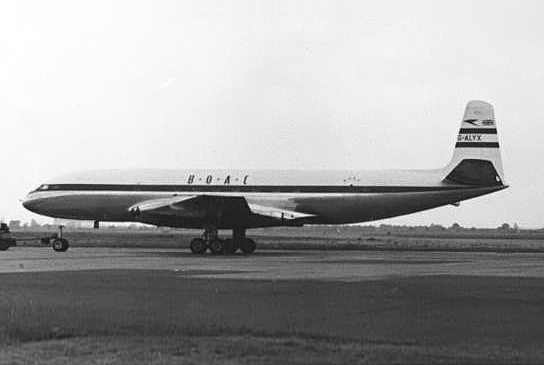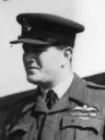G/C Geoffrey Womersley DSO, DFC (BSAA Captain)
 Geoffrey Womersley, one of the most fearless Pilots of Bomber Command’s Pathfinder Force during WW2, who was awarded 2 DSOs and a DFC. (died aged 96). He was already an experienced member of Bomber Command when he volunteered for the Pathfinder Force on its Formation in 1942, joining one of its’ original 4-Squadrons. The Pathfinders used specialised Target finding & marking techniques developed for all forms of weather conditions, including nights when it was completely overcast. Using a combination of personal skill & technical equipment, and often flying against overwhelming odds and in appalling conditions, Crews transformed the performance of Bomber Command.
Geoffrey Womersley, one of the most fearless Pilots of Bomber Command’s Pathfinder Force during WW2, who was awarded 2 DSOs and a DFC. (died aged 96). He was already an experienced member of Bomber Command when he volunteered for the Pathfinder Force on its Formation in 1942, joining one of its’ original 4-Squadrons. The Pathfinders used specialised Target finding & marking techniques developed for all forms of weather conditions, including nights when it was completely overcast. Using a combination of personal skill & technical equipment, and often flying against overwhelming odds and in appalling conditions, Crews transformed the performance of Bomber Command.
It was as one of those Pilots that Group Captain Womersley, as he was later to become, attacked Targets in Germany & Italy dropping flares to illuminate the Targets often during lengthy & exhausting Missions. In January 1943, whilst still a junior Flight Lieutenant, he was awarded a DSO the citation for which said: “He has displayed outstanding ability and pressed home his attacks with unusual courage in the face of the Enemy Fighters and anti-Aircraft opposition.” He went on to complete 25 Operations during the Battle of the Ruhr, and a few months after receiving his DSO was awarded a DFC for “pressing home his Attacks with grim determination“.
In April 1943 he joined the Air Staff at Pathfinder Headquarters, taking Command of 139 Squadron 10 months later and seeing Operations against Germany’s most heavily defended Cities, including Berlin, Munich & Frankfurt. Often acting as Master Bomber, he directed other Bombers to aim at the many marked Targets in Operations that involved him staying over the Target, under fire, for long periods until the Attack was completed. On the night of 12th May, he led 9 Mosquitos dropping Flares to mark the route & illuminate the Target in support of a Squadron of low-flying Bombers in a successful raid dropping Mines in the Kiel Canal. On another occasion, he descended to low level over Mannheim, in the face of intense anti-Aircraft fire, to give accurate instructions to the Bombers above. For that, he was awarded a Bar to an earlier DSO.
Group Captain Womersley was born in Bingley, the son of a Mill Owner, and educated at Bradford Grammar School. His father wanted him to go into the Family Business, but he had his heart set on joining the RAF, which he did in 1936 Training as a Pilot at the RAF’s Flying School in Egypt. His flying Career began on Biplane Bombers and on the outbreak of War he dropped propaganda leaflets over German Cities and Bombed German Seaplane Bases. On the night of 11th May 1940, he flew on the RAF’s 1st Raid on a German Town, when 37 Aircraft Bombed road & rail links at Monchengladbach. His Squadron also supported the British Expeditionary Force. He went on to complete 30 Operations, mostly against German road & rail targets, before becoming a Bombing Instructor. After attending the USAAF Staff College, he was promoted to Group Captain Commanding the Pathfinder Airfield at Gransden Lodge near Cambridge.
He left the RAF in November 1945 and a year later, along with fellow former Pathfinder Crews, joined the newly established British South American Airways. Early in 1946 Donald Bennett established British South American Airways, whose civilianised RAF bombers and flew routes to the Caribbean and South America. Many of his ex-Pathfinder crews joined him, Womersley among them. The airline later used the Avro Tudor, one of which was lost without trace in the Bermuda Triangle. Womersley was one of the Aircraft’s few fans, describing it as “the best civil airliner flying“.
 On 10th May 1954, following the Airline’s merger with BOAC, Womersley flew a Comet into Rome Airport, where another Crew took over for the Flight to London. Shortly after take-off the Aircraft suffered an explosive decompression and crashed into the sea off Elba; there were no survivors. He retired in 1968 as one of its Senior Boeing 707 Captains.
On 10th May 1954, following the Airline’s merger with BOAC, Womersley flew a Comet into Rome Airport, where another Crew took over for the Flight to London. Shortly after take-off the Aircraft suffered an explosive decompression and crashed into the sea off Elba; there were no survivors. He retired in 1968 as one of its Senior Boeing 707 Captains.
Rome’s Ciampino Airport, the site of the 1st Comet hull loss, was the origin of more disastrous Comet Flights just over a year later. On 10th January 1954, 20 minutes after taking off from Ciampino, the first production Comet, G-ALYP, broke up in mid-air while operating BOAC Flight 781 and crashed into the Mediterranean off the Italian Island of Elba with the loss of all 35 on board. With no witnesses to the disaster and only partial Radio Transmissions as incomplete evidence, no obvious reason for the crash could be deduced. Engineers at de Havilland immediately recommended 60 modifications aimed at any possible design flaw while the Abell Committee met to determine potential causes of the Crash. BOAC also voluntarily grounded its Comet fleet pending an investigation into the causes of the accident.
On 8 April 1954, Comet G-ALYY (“Yoke Yoke”), on charter to South African Airways, was on a leg from Rome to Cairo (of a longer route, SA Flight 201 from London to Johannesburg), when it crashed in the Mediterranean near Naples with the loss of all 21 Passengers & Crew onboard. The Comet Fleet was immediately Grounded once again and a large Investigation Board was formed under the direction of the Royal Aircraft Establishment (RAE). Prime Minister Winston Churchill had tasked the Royal Navy with helping to locate and retrieve the Wreckage so that the cause of the accident could be determined. The Comet’s Certificate of Airworthiness was revoked and Comet 1 Line production was suspended at the Hatfield Factory while the BOAC Fleet was permanently grounded, cocooned & stored.
A scratch golfer in his youth, his golf clubs accompanied him everywhere, sometimes stowed in the Cockpit of his Aircraft. He played until he was 91 when he broke a leg and was forced to retire from the game. He married his childhood sweetheart, Dorothy Allsop, in Driffield, on 8th September 1939 whom he had met through one of his 3 sisters. They were planning to marry at Bolton Abbey but by then War had broken out and he was Stationed at RAF Driffield. She died in 2002. Although he settled in Surrey after the War he always retained his Yorkshire links, especially through his grandmother who lived in Bingley until she died about 20-yrs ago aged 101. Womersley was a well-built, impressive-looking man with a natural presence, known for his unflappability & modesty. He is survived by his only daughter Pat.
